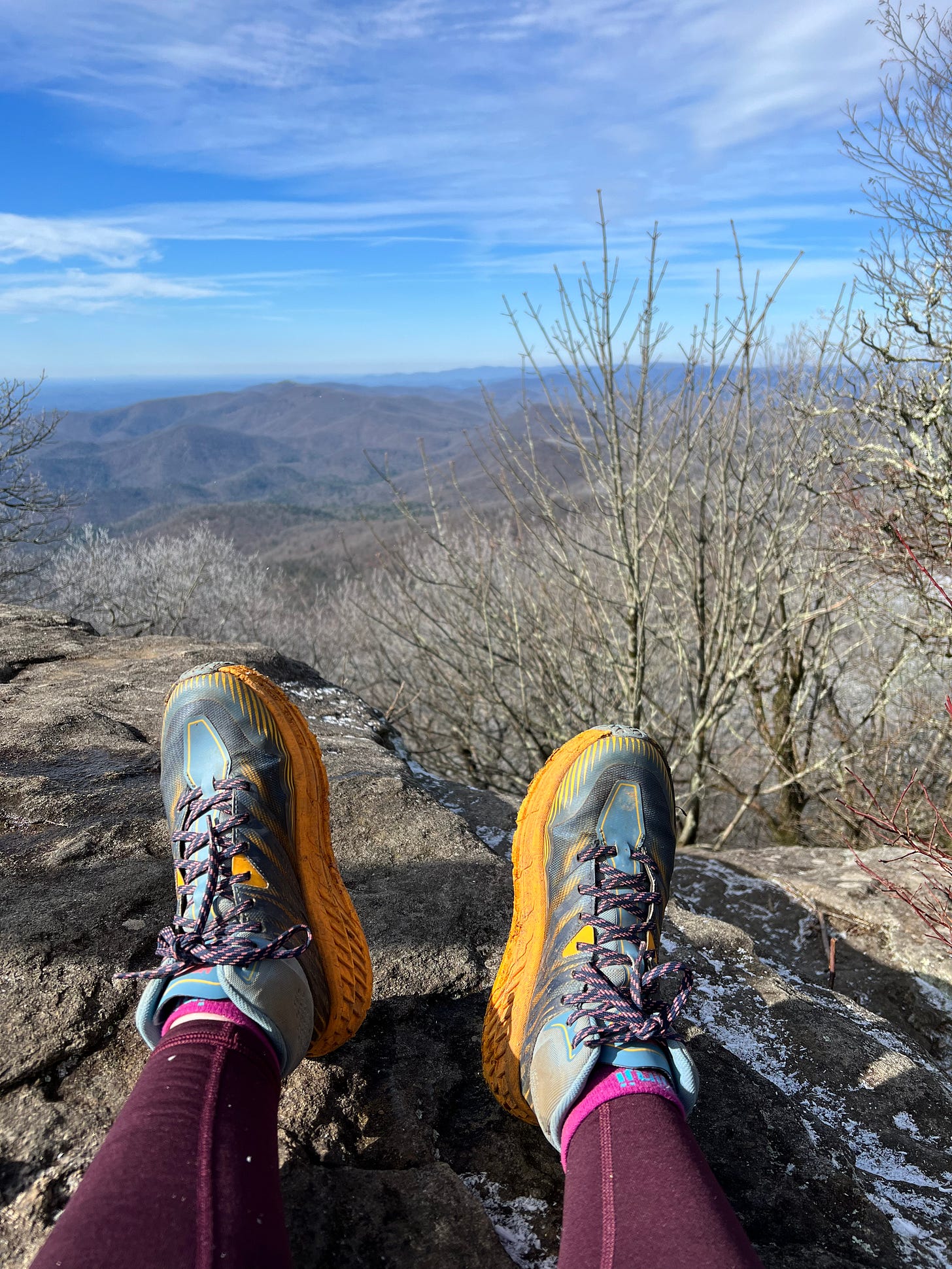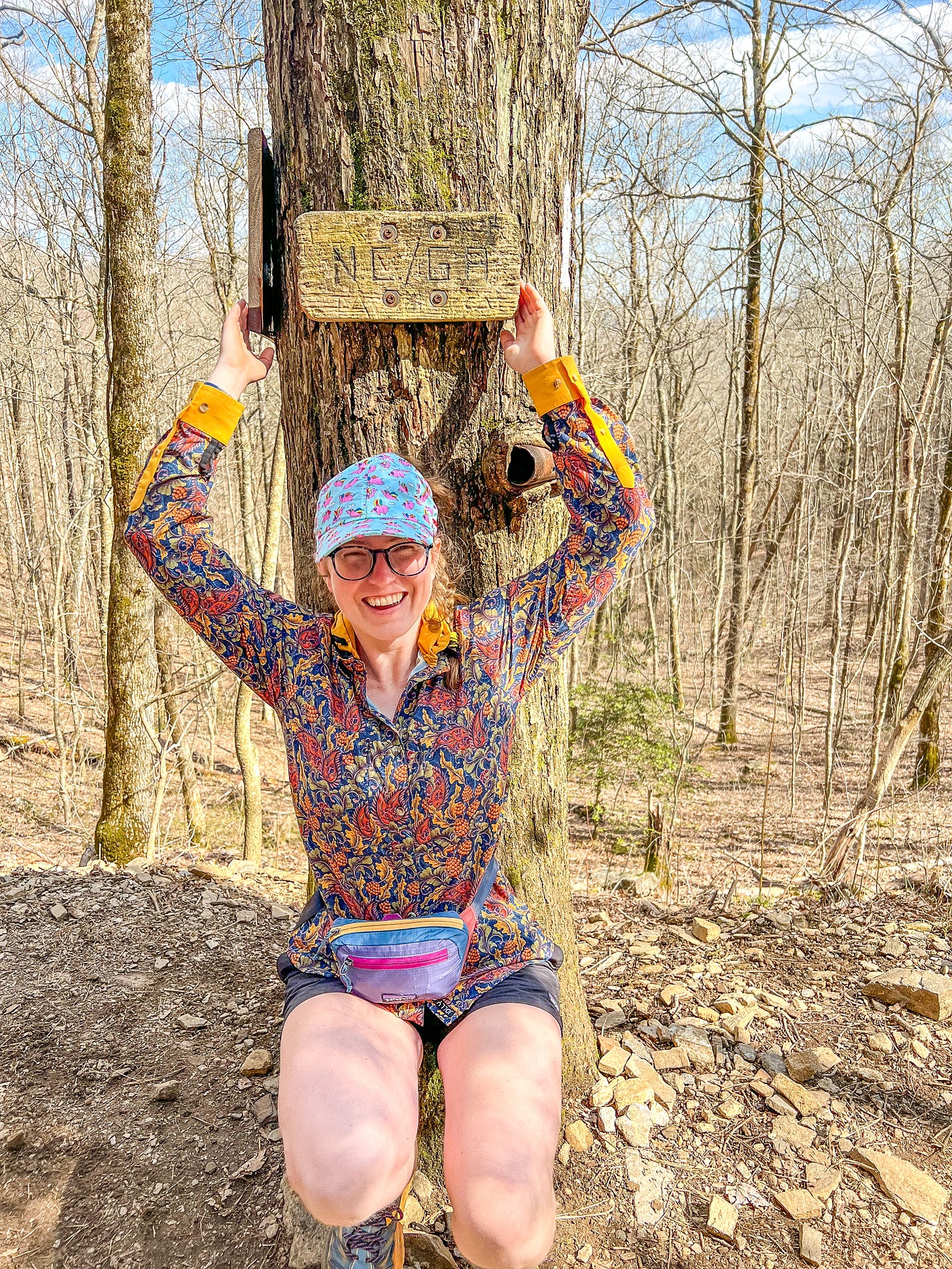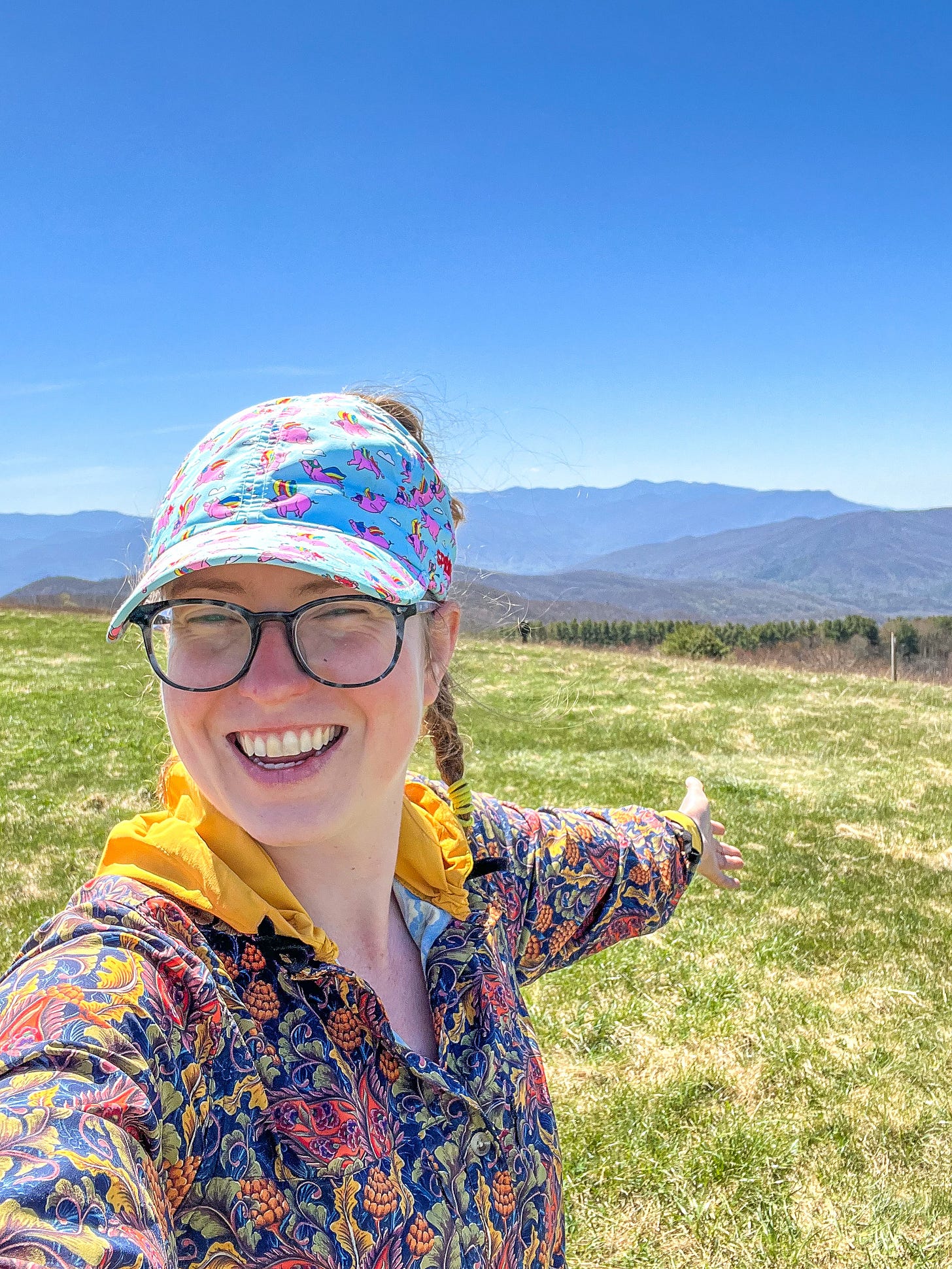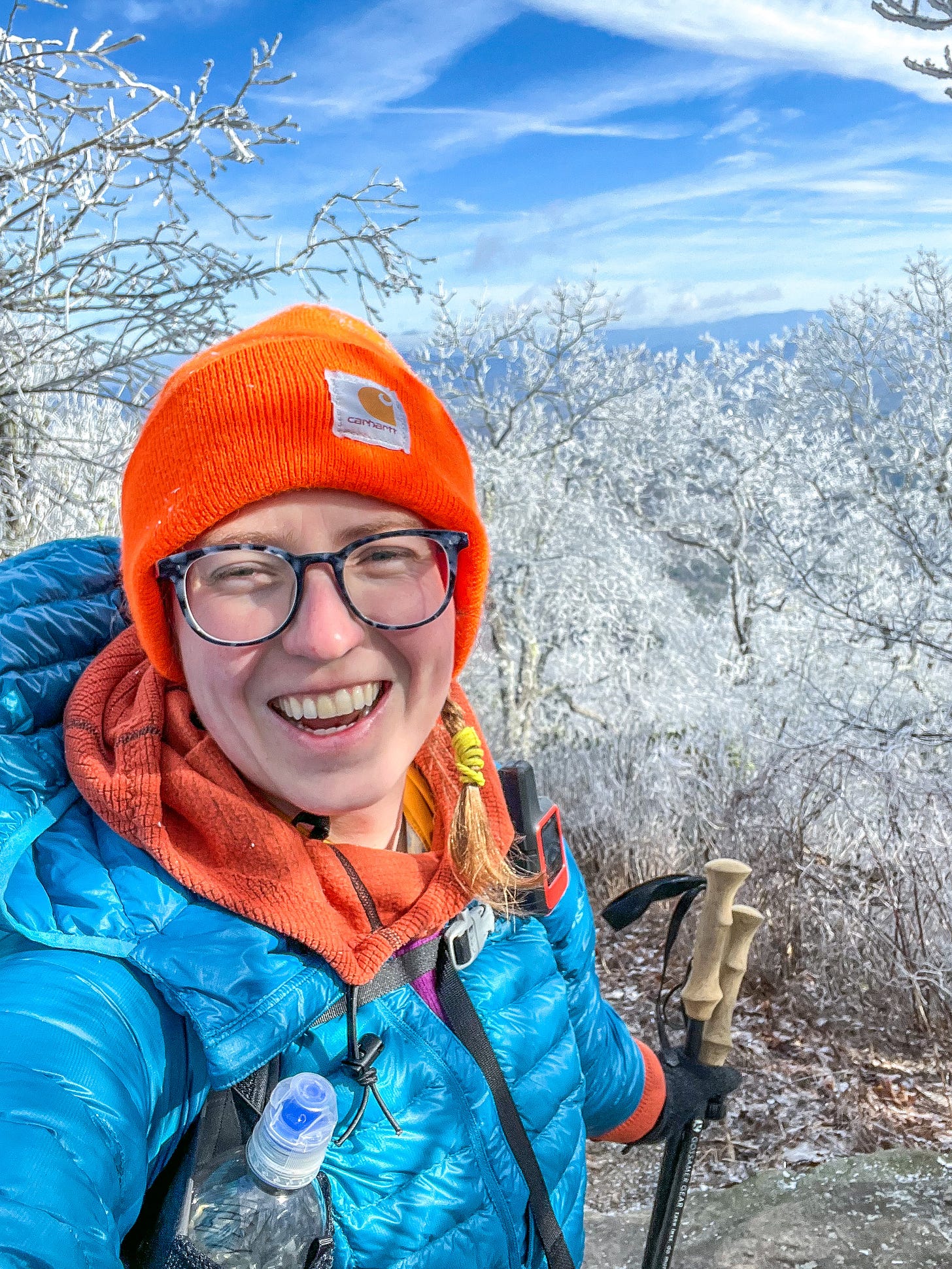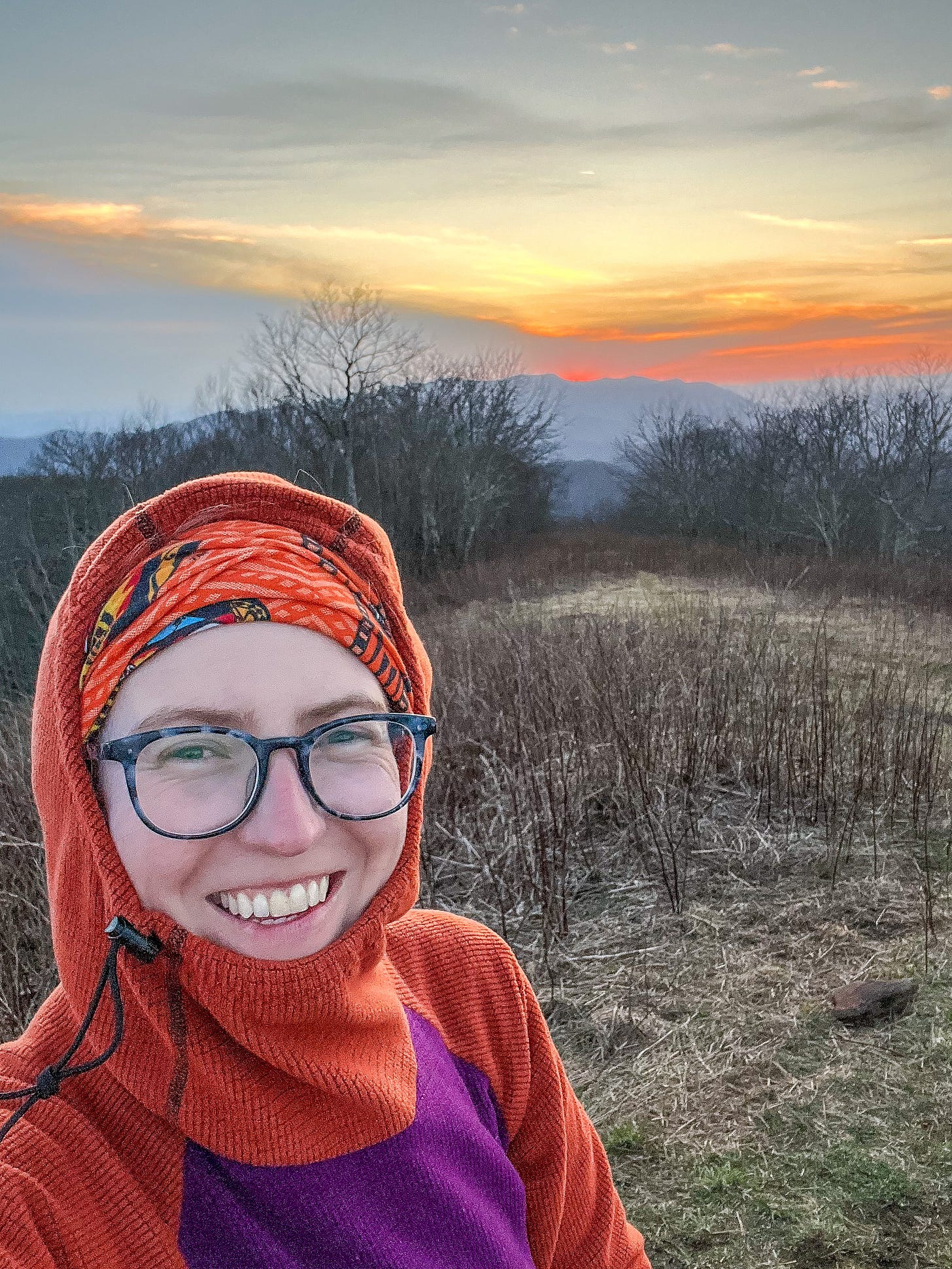Treats' Favorite Appalachian Trail Gear
Treats' FAVORITES of the Appalachian Trail Gear that made it all the way to Katahdin!
For 6 years, I read every article, book, listened to podcasts, watched countless Youtube videos, and researched the heck out of the gear I would one day bring on my thru-hike of the Appalachian Trail. In 2023, I’m proud to say I thru-hiked the Appalachian Trail from Georgia to Maine in a little over 6 months.
Most of the gear I started my adventure with, made it all 2,198.4 miles down the trail (you can read my blog post about all the gear that made the entire trail here or watch the full post-trail gear video on YouTube here) But there is a difference between the gear that stood the test of time and the gear that I absolutely LOVED. There was even some gear I loved so much that although I probably should have sent it home, I held on to it the entire trail.
Friends, buckle up for this one, it’s a long post… but it does have lots of thoughts on my favorite pieces I took with me down the Appalachian Trail.
This breakdown lists everything that made it to Mount Katahdin with me AND that I absolutely LOVED. I’ll then share why I loved each piece so much and what made it special enough to hike the entire Appalachian Trail with me. All of the gear listed below, I would take with me on another thru-hike.
If you would rather watch this than read it, you can watch my favorite Appalachian Trail gear video on YouTube here
For gram weenies who just want to see the weight of these favorite items, visit my Lighterpack here.
Now let’s get to the reason you’re really here, the coveted, favorite gear:
*some of these links are affiliate links which helps fund my next adventure, at no extra cost to you
Backpack: Osprey Eja 58
I have loved Osprey packs for years. I have a purple Osprey Sirrus Daypack that’s named Ranger Rick. It’s been hiking, mountain biking, skiing, and on all kinds of countless adventures with me. So I knew Osprey packs were reliable and withstood the test of time. I also knew that since it was my first thru-hike and that I am an overpacker it was highly unlikely I would be ultralight. Because of this fact, I thought it would be smart for me to use a framed-pack.
My first Eja I had been using and testing for a few months prior to trail - I was happy with it and all was going well. All the sudden on one of my shakedown hikes it was squeaking horribly. Some kind of mechanism was not happy. I contacted Osprey support, sent in my pack, they couldn’t fix it so they were going to send me a replacement. I wasn’t sure the replacement would get here before my start date so I tried out some other brands. They did not work for me at all. In the end I ended up with a brand new Eja that I started the Appalachian Trail with.
I loved my pack. For a framed pack, it’s relatively lightweight (45 oz) and most importantly it was comfortable. It withstood the test of time - it walked over 2,000 miles with me through all kinds of weather, it butt-scooted in the White Mountains with me, every moment on the trail this pack made it through. And although it looks a little worn after the adventure, the only blemish on my pack is a little hole in the front mesh from my butt scooting against rock faces.
Ospreys might be a little bit heavier but they are hearty packs. They will withstand the elements and the test of time and I would take my Eja on another hike in a heartbeat.
The Eja is the Women’s version of the Exos. My boyfriend won an Exos at Trail Days and absolutely loved hiking the rest of the trail with it. His gear was not ultralight either so switching from a frameless to a framed pack, helped distribute the weight a lot better for him.
Sleeping Bag: EE Enigma Sleeping Quilt
Until I started diving into the thru-hiking world, I had no idea that quilts were even an option. I thought that I would forever be stuck in a sleeping bag. My life has now changed.
For those who are unfamiliar, a quilt is like a sleeping bag but the backside is open. Most of the feathers in a down sleeping bag don’t offer much insulation on the underside of your bag. Because of this quilt designers decided to cut down on weight and get rid of that section. Don’t worry though, most quilts still come with some kind of method to easily cinch the quilt around yourself and your sleeping pad.
I am a side sleeper which can create more than a few complications when sleeping on the ground. But one of the many complications is that most sleeping bags are made for people who sleep on their backs. I very rarely can fall asleep flat on my back and love to curl up like a little armadillo. Then I found out about Nemo Equipment who makes spoon bags for side sleepers. Nemo makes great gear and I honestly love my 15* Disco bag, but what it ultimately came down to was weight.
Both quilts and Nemo bags are great for side sleepers. However, quilts are significantly lighter and my quilt is half the weight of my Nemo bag. I love my Nemo bag but anytime I need to save on weight and still want warmth, my Enigma is Queen. I got a 10* bag because I sleep cold and it was truly perfect. I loved getting cozy and snuggly in it every chilly night.
It did take me a little while to get used to not having a back or a hood in my quilt. And I also had to get used to placing the back clips in the right spot so when I flopped around at night there was not a draft. But once I got myself settled, in the right position, my quilt was the coziest little cocoon out there.
*I did get the Enigma which comes with a sewn in tow box. This kept my feet warmer as someone who has very cold feet. I also dealt with not having a hood by usually wearing my Melly and beanie to sleep when it was cold and that was great. Lastly, I did get the cinch cord put into my quilt so that I could cinch my quilt around my neck like a cocoon.
It might sound silly that this is under my list for favorite gear, but it is honestly astonishing how much of a difference a trash compactor bag can make during your hike. I will truly never go backpacking without one again.
One of the most miserable things about thru-hiking is being rained on for multiple days in a row and constantly being wet. And the most miserable thing is when everything inside your pack also gets wet and you have nothing dry or warm to put on after a day of hiking in the rain. The good news is, the fix to this is easy - line your bag with a trash compactor. It’s lightweight and as long as you roll the top up, even if your pack is soaked, the stuff inside the trash compactor bag is dry. And later on, when you can put on warm socks and dry fleece, you will be just as excited about a trash compactor bag as I am.
And yes, you can spend a little bit more money for something that’s a *tad* lighter from a fancy gear company, but frankly I don’t like how crinkly those are and a normal trash compactor bag worked phenomenally for me.
Justin's UL Smartwater Water Bottle Holder
While I love everything on this list, this is probably one of my favorite favorites - that’s how much of a difference it made for me. When I was doing my shakedown hikes before starting the AT, I discovered that my tiny arms could not reach back into my side pockets and pull out my water bottles… this was a problem. If I was hiking alone, I’d have to take off my entire bag to get water or become more flexible in the arms. Or everytime I wanted water, I’d have to ask someone to grab it for me. That was not going to be good for introvertness or my hydration.
This Water Bottle Holder is truly the perfect solution. Not only is it so lightweight that it literally feels like nothing, but it’s super easy to attach to any pack and it made a world of difference for my tiny t-rex arms. All throughout the trail, it was easy for me to stay hydrated and it allowed me to distribute my water to my front and one of my sides.
*I will say after 2200 miles, mine did have some wear and tear on it, but I loved it so much that I will be replacing it before my next backpacking adventure.
HOKA ONE ONE Speedgoat Mid 2 GTX Hiking Boots - Women's
Before I was a thru-hiker I was a seasoned runner (and I still run). There came a point in my amateur running career where I had extreme pain in the ball of my foot whenever I would do more than a few miles. No matter what I tried, every shoe bothered me. And then came the day when I started doing longer hikes and my feet were also not happy in hiking boots after a few miles.
I can’t recall who recommended I try Hokas, but they fixed the problem. I very rarely have pain in my feet now that I switched to Hokas. When Hoka released their hiking boots, I knew that if I wanted to do more than 5 mile days on the AT pain free that I needed to try them. I am obsessed and will *probably* never go back to a different shoe. I did have some foot issues on the trail, but I think that was more on me not changing my shoes as frequently as I should have or having the wrong size. But besides a few moments that I can count on one hand, these shoes helped my feet survive down the trail.
I also will note that I did not have the trail runner Speedgoats. I am a clutz and tend to roll my ankles a lot so I went with the Hoka Speedgoat Mid-Tops. Although they are a little bit heavier than a trail runner they are lighter than a traditional leather boot, and the extra support they gave my ankles was worth the little bit of extra weight.
Jolly Gear Triple Crown Button Down Sun Hoodie
Included in top tier gear is my Jolly Gear Sun Hoodie. I am truly obsessed with these shirts. If you’ve seen photos of me, you’ve probably noticed that I am very fair skinned, myself and tanning have never gotten along. So even though most of the AT is in a green tunnel, I knew that to protect my pale skin, I would need a lightweight sun shirt.
For years, I’ve been wearing lightweight Columbia shirts. I’d wear them to the beach, when I was coaching on the pool deck, on a boat, on a hike, on bike rides, to Disney World - literally anywhere that my shoulders could be at risk, I wore a Columbia shirt. And don’t get me wrong, I love a good Columbia shirt, but I also love a fun pattern.
I discovered Jolly Gear at Trail Days in 2022. I walked past their tent and saw all these brightly colored, fun patterned hiking shirts. After feeling the shirts, seeing that they were lightweight, had thumbholes, a ponytail hole for my hair, AND they were made by a thru-hiker (Jolly), I was sold (& my mom was too).
My Jolly Gear Triple Crown Button Down Long Sleeve in the Wicked Weeds pattern walked 2,198.4 miles with me. I wore that shirt almost everyday for over 6 months straight and I freaking loved it. After many months on trail, it is starting to wear in the shoulders and it does smell a little bit, but I will talk about how much I love my Jolly Gear shirt until the cows come home. There might be a little lighter weight or cheaper options out there, but nothing quite as cool looking or thru-hiker owned.
Jolly Gear > Columbia everyday.
This might seem like a silly thing to be a favorite but my Branwyn Merino Wool Bra made a big difference for me. When I am moving, I am generally warm and sweating - my body temperature generally heats up really quickly. But when I stop moving, my temperature falls really quickly and I easily get cold.
I noticed when I was doing weekend backpacking trips, my normal sports bras would get sweaty and then that dampness would make me colder after I stopped moving. I had heard about Branwyn but finally decided to get one for my thru-hike so I could stay warmer.
I really loved this bra. It’s merino so it helped wick away moisture keeping me dryer (not dry but dryer), it’s less stinky (it was the least stinkiest of my worn gear), and it helped me manage my temperature better. Which was exactly what I wanted it to do. It was perfectly comfortable for my hike. The straps are adjustable so you can tighten them to your preference, it didn’t rub me in any weird ways, and it was so comfy, I’m continuing to wear it all the time now that I’m off trail.
*I will give the caveat that when I first put it on it was a little scratchy but once I wore it for a little while, it was super cozy.
**My second caveat is that when this bra does get wet, it takes forever to dry. But it does take longer than a normal bra to get to that soaking wet stage.
If you’re looking for lightweight gear, sometimes the best place to look is other sports. This is not a hiking hat but a hat generally meant for runners, and it is wonderful.This hat checked all the boxes - sun protection, lightweight, and cute patterns.
As mentioned above when writing about my Jolly Gear shirt, I am very fair skinned, so sun protection is very important to me. Besides that I love to protect my skin, I don’t love the feeling of sunscreen on my face (even though I did use it), This hat made protecting my face on the days that we weren’t in the green tunnel better.
Before leaving for trail and even on trail, one of my greatest fears was ticks and I knew if a tick somehow found its way onto my scalp there might have been no chance of ever finding it. So my way to give myself peace of mind was a hat and I never found a tick in my hair.
This hat is one of the most lightweight hats I’ve ever found (I’m sure there’s others.) I loved that it didn’t rub against my forehead when I sweat and just how lightweight it was no matter how wet it got. And when it did get dirty, I threw it in the wash multiple times and it came out looking good as new.
*I will say that part of the reason I loved this hat so much is because my mom custom modified it for me by cutting and then sewing a high ponytail hole in it. I like to keep my hair off of my neck and this made my life so much better. Most hats that have high pony holes are not lightweight material so this made it the best of both worlds.
P.S. If any gear company happens to be reading this and wants to make a lightweight, high pony tail hole hat, I volunteer as gear tester or just to buy one cause this is a needed thing for the hiking and running community.
Patagonia Ultralight Black Hole Mini Hip Pack
I love ultralight packs, but the downfall with many of them is that they either don’t have hipbelt pockets at all or they don’t have big enough hip belt pockets. Then enters the fanny pack. This tiny piece of gear made such a big difference for me on many aspects of my hike.
As I said above, hip belts are not big enough. Everything I wanted to easily access would not fit in them. Because of that I would divvy up everything I wanted to grab between my fanny pack and my pack. My pack pockets would usually be loaded with snacks for the day while everything else I wanted on hand was in my fanny pack. That meant my fanny pack held my headphones, sunglasses cover, iPhone, chapstick, face sunscreen, wallet, and my pepper spray. My tiny little fanny pack held all of that gear AND allowed me to have easy access to it.
Besides that my fanny pack made it easy for me to grab all of my favorites while hiking, it also was great to use in town. Whether we were in a hostel, going to dinner, going to the grocery, having my hands free was really wonderful and made town life easier for me to keep track of some of my most important items.
This was not the first fanny pack I tried for trail. I had another one prior to starting the AT and something about it just didn’t work for me - it pulled on my back weirdly when I put anything heavier (like my phone) in it. It wasn’t going to work for 2,000+ miles. So when I found this cutie little Patagonia fanny that fit everything I needed, felt good on my waist, and came in cute colors - I was sold.
The colors look a little worn for wear post trail, but I still use this fanny pack post trail and would take it down another trail in the future in a heartbeat.
I feel like some people might roll their eyes at this one, but I am obsessed with my Carhartt Beanies. I know that there are lighter, trendier, cuter options out there but with the price, warmth, and comfort that these hats provide, you will probably never catch my in another beanie brand.
Whether I’m on trail or at home, if it’s chilly I have my Carhartt Beanie on. My ears and head can get chilly especially at night and the thick knit of this beanie kept me cozy (sometimes with the addition of my hoods) on every chilly night the trail threw at me.
It’s probably not the most perfect beanie out there, but it’s perfect for me and I will continue to wear these until I find something I like better.
P.S. They come in all kinds of colors, including blaze orange - which although hunting generally isn’t an issue on the AT, this color can help people spot you in any type of outdoor situation. Win-win.
Melanzana Micro Grid Hoodie V2
When everyone else started sending their fleeces home in the height of summer, my Melly stayed in my pack with me. Cozy, warm, and colorful, I wore my Melanzana on the trail more than I wore my puffy. If it was a chilly night, the first thing I was putting on was my Melly and then cinching the hood to snuggle in.
Besides the colors, the Microgrid Polartec fabric, the hood that cinches around my neck and face, wearing my Melly after a long day felt like a cozy blanket back home. In a way, I was like Linus from Peanuts and my Melly was my comfort blankie. And even in the height of summer, I wasn’t sending it home - I knew as soon as chilly moments came back, I would want it. Is it the lightest, most perfect fleece for thru-hiking on the market? Probably not. But when carrying a cotton hoodie is a bad idea for thru-hiking, this fleece was the coziest thing I carried, it’s relatively light, and I would do it again in a heartbeat.
I will say, the only thing I wish was different about my Melanzana is that I wish it had thumb holes, but otherwise it’s perfection in my opinion.
P.S. While I do think the official Melanzana Hoodie is the best, I know that they are not easy to come by. There are many brands making similar ones that also look pretty nice like Mountain Hardwear, Senchi Designs, LightHeart Gear, Superior Fleece, Youer, Squak, or FayetteChill (I have not tried any of these alternatives).
Adhesives : KT Tape / Leukotape
These might seem like small items but they can make a huge difference in your hike. When you are starting to feel some strain, pain, or blisters, these two tapes might be your hike saver.
For those who haven’t heard of KT Tape, it is a thin, flexible, and sometimes colorful tape that can help with muscle movement and enhance athletic performance. Before trail I used KT during my Dopey Challenge (including my marathon) and it saved my knees & hips. On trail, my knees started bugging me from the descents in the White Mountains and KT helped them feel better for the last few descents. I had a few friends who hadn’t heard of KT tape who were having knee or hip issues and after lots of convincing they finally tried it and loved how much it helped them.
Leukotape my was feet saver and therefore my trail saver. When trail talk goes to blisters people share lots of different remedies and I have tried them all - the only one that worked for my blisters was Leukotape (and my Injinji’s). When I was training for my marathon/Dopey Challenge before trail, I got blisters all over my feet and couldn’t find any kind of solution. I was terrified that I would have to get off trail due to a blister infection of some kind. But with a combination of my Injinji’s and Leukotape, I was able to stay mostly blister free for the entirety of the trail.
The reason that Leukotape was better than anything else I tried was because it actually stuck to my feet. I sweat a lot and so blister bandaids, moleskin, I would find every single one in every other place in my shoe besides on my blister. Not the Leukotape - it *usually* stuck for days right where I needed it to and let blisters heal.
If you are someone who squats when you pee, a Kula Cloth will be a game changer for you - it was for me. I honestly used to hate having to pee while hiking. It was such an inconvenience to carry toilet paper and pack it out and it also felt really wasteful. Then a few years ago, I heard about Kula Cloth / pee cloths. I had heard of pee rags before (using a bandana to wipe and then letting the sun cleanse it on your pack) but never something like the Kula Cloth.
What makes a Kula Cloth special is that it is an antimicrobial, reusable pee cloth that comes in so many fun designs and is a really awesome small business, owned by some badass people. My Kula Cloth snapped to my backpack, it snapped to itself for privacy and cleanliness, it has reflective thread on it so it was easy to spot at night with your headlamp, it has anti-microbial silver infused on the side where you wipe, and a waterproof clean side for you hands.
As a woman, peeing in the woods is such a pain. And if you don’t squat when you pee, you don’t understand. Not having to deal with toilet paper made my trail life so much less stressful and the Kula Cloth made it so easy to pee, wipe, and continue going down the trail. And when I was in town, it was so easy and convenient to throw it in with the rest of my wash. It just made trail life easier which is always a good thing.
Having a Kula Cloth makes peeing in the woods better & easier. Trust me.
P.S. If you feel the need to leave a rude comment about this, please don’t. If you don’t want to use one, don’t. But my Kula Cloth made my trail bathroom experience much easier and cleaner.
As a woman who menstruates, thinking about how I would deal with my period on trail was one of the most stressful thoughts that plagued my brain when planning gear. Now that I have my Saalt Cup, I will *hopefully* never stress about a period on trail again.
*If periods and the associated conversation gross you out, skip the next few paragraphs.
I hate tampons - I find them uncomfortable in all facets and I did not want to be carrying around a bag of them to pack in or a bloody bag to pack out. I don’t hate pads, but it’s never very fun to hike around feeling like you’re wearing a giant diaper. And once again, I did not want to be carrying a big bag of these. I also tried period underwear and while I love the idea of these, there was no good way to be able to clean these on trail. I had tried a menstrual cup a few years prior and it didn’t work for me, but with all the above in mind, I dove into research to try again because it seemed like the best option for me on trail.
I won’t get into the nitty gritty (but if you want a future post or video dedicated to women related stuff on trail, let me know) but basically I discovered that the cup I had previously been using wasn’t right for my body. But after researching, chatting with friends, and chatting with the team at Salt (they truly want their product to work for you, they emailed with me), I decided to try again. This cup was much softer and fit better. Although it took a little while to get used to and to make sure I was using it correctly, I was hooked. I didn’t have to deal with pads, tampons, or any of that mess. I just had to make sure my hands were clean when inserting or removing the cup and once I learned how to use it properly it is the easiest (and most sanitary) way I’ve ever dealt with my period. 10/10 would take again.
Before I completely wrap this up, I know that buying gear is expensive - especially nice, lightweight gear. I had friends who successfully hiked the trail in many different kinds of things, we’re all different and each piece of gear is enjoyed by someone differently. However, in case this helps you, here are my top 3 pieces of gear from this list (as a treat for making it this far):
Melanzana Micro Grid Hoodie V2 - alternatives to this one listed above
*4. I’m giving a 4th because this one would be #3 but it doesn’t apply to everyone. Saalt Menstrual Cup - for my friends who menstruate, I truly can’t describe how much better my period experience on trail was because of this small item.
The gear you choose to bring in the outdoors can be a determining factor on how much you enjoy yourself. And while my favorites might not be everyone’s favorites, I hope you find something off this list that you love & that makes your next backpacking trip wonderful!
If you have any questions, comments, or want to share your favorite gear, feel free to leave a comment or send me a private message on Instagram - I’d be happy to go into more detail about anything above!
Happy Trails!
Treats





